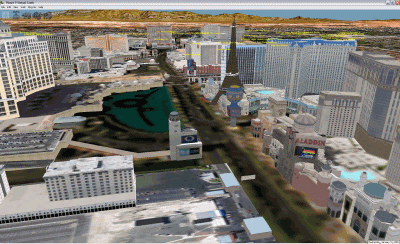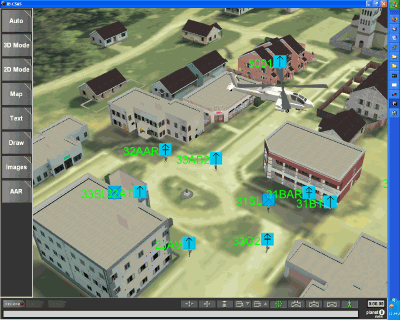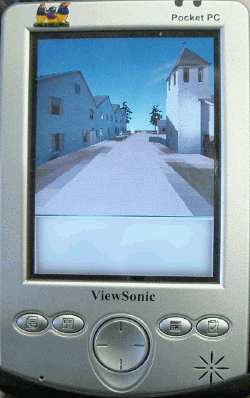Planet 9
Sometimes my job requires me to ferret out the inconsistencies between products and the accompanying marketing spin. But at other times, it's enough to keep up with the progress, take a drink from the fire hose and press on. Take Planet 9 Studios for example. The company provides virtual city models with remarkable realism (See Figure 1 below of Las Vegas). The imagery is lifelike in appearance and even knowing how they did it, you wonder about the work that it took to render the images to such clarity. And if you must know how they did it…think side-looking airborne radar, LiDAR, and aerial photography integrated into a common, geo-referenced database, along with many other sources. The company's president, David Colleen, touts the defense industry as the company's key market (Blue Force tracking [technology that helps tell U.S. military units where friendly forces are located - See Figure 2 below], port security and situational awareness). The company also works with those in the entertainment, gaming, and TV news business. To me, it's just another data point indicating where location technology is going. Most impressive however, is the vision Colleen has for in-vehicle navigation. Forget that the TomTom Navigator, a portable in-vehicle system, can tilt the view of the roadway to give you a "quasi-3D" visual of direction and location. Planet 9's eScene (Figure 3) can render the view to show you the building facades so that you can see if you are in the right location. It is this kind of innovation that has yet to make it into the consumer or commercial application markets. But you can see it coming.

Figure 1 (Click for Larger Image)

Figure 2 (Click for Larger Image)

Figure 3 (Click for Larger Image)
Colleen also believes that "3D models will be used as an interface to data." You need to let that one sink in a bit. Our reference has always been 2D maps. And for those with a high degree of geographic literacy, 3D is a logical step for data visualization of geospatial or associated aspatial data. But if, for some reason, you are cartographically challenged, only a "real" picture will do, or at least a 3D model with extreme authenticity. The difference between the rendered Planet 9 models and Microsoft's Live Local maps with Pictometry's off nadir aerial imagery is the ability of the Planet 9 models to tilt, pan, zoom and query the models for richer attribution. In the case of a military application, the user can ascertain the location and movement of troops, weather, or determine the contents of a building with an "x-ray-type" view. The scene is not static but a "live" representation of information.
InfoSpace
InfoSpace's entire focus is on the mobile handset. The company is supplying its content of local information (movies, bars, restaurants) to cellular carriers to enhance the mobile search experience. The company uses Microsoft's MapPoint Location Server for its location-based search engine so the results of a search can be either text or maps or both. Maps on phones are nothing new. InfoSpace's main goal is to enhance the mobile experience by getting information to the phone with minimal clicks. As with many LBS applications, the map is the interface. InfoSpace is one of those companies in the "supply chain" of location-based information services. (More on that later.)
Yahoo, Microsoft, Google
Let's sidetrack to those with a slightly different view. Take Yahoo! Yahoo!, by CEO Terry Semel's own admission, is an entertainment company. So why are they in the mapping business? I'll come back to that. Now, Microsoft. What got Gates jazzed about the Virtual Earth? It wasn't that is was simply cool software because Bill loves cool stuff. It was a way to deliver information through a unique interface. Microsoft, of course, straddles the fence between a software and entertainment company and I'm not sure they've determined which way they will lean in the future.
Google? Founders Larry Page and Serge Brin believe that Google is an "information technology" company. What better way to deliver a textual search than with a picture. How often during your Google search do you hit the "Images" link as well? Why not add a "Map" link too? If I ever want you to find me using Google, then I might opt to reveal my location. But not yet.
The Trend
Do you see the trend? Taken together, software + information + entertainment = "infotainment". Add a geospatial context: location + search + context = "infotainmaps." The companies mentioned above represent the front lines in location technology innovation and information delivery, i.e. search. They are providing the backbone and the "second to last mile" to the consumer, whether it is for individual or commercial use. The true last mile will be driven by the carriers, cellular companies that put handset in hands and information that reaches eyes and ears. The battle lies at the interface. If Colleen is correct, his realistic 3D models, in addition to other forms of map innovation, represent a catalyst to mass adoption and understanding. Are you ready for the infotainmaps?